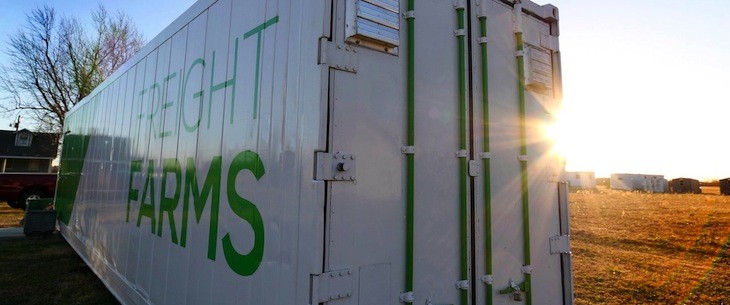‘Freight Farms’ in Northwest Arkansas reflect hydroponic, urban farming trends
by January 29, 2018 4:34 pm 2,423 views

More than 12,700 heads of lettuce in two years have been harvested from the University of Arkansas Freight Farm, a hydroponic vegetable farm contained in a 40-foot-long freight shipping container.
UA is one of several Arkansas organizations that have purchased a “farm-in-a-box” product from the Boston-based startup Freight Farms, which makes its units with “upcycled” materials, according to its website. The site says there are now Freight Farms in 30 states and nine countries.
Harvests from the university’s Freight Farm provide 100% of the leafy greens used on campus at Where the Wild Greens AR, a retail concept serving grain bowls and salads, said Scott Flanagin, executive director of communications in the Student Affairs division of the UA.
The UA grows Rex butterhead lettuce and arugula on its farm, and during previous semesters since it was installed in August 2016 has grown other lettuce varieties and herbs, in response to changes in the offerings at Where the Wild Greens AR, run by the school’s dining service, Chartwells.
“The Freight Farm was brought to campus by Chartwells and Student Affairs with goals of providing fresh, hyper-local produce and promoting student success and education,” Flanagin said.
Two undergraduate students now manage day-to-day operations. Freight Farm interns typically spend two semesters each running the farm. All Chartwells interns, regardless of pathway, have spent time on the Freight Farm since its inception. The Freight Farm company said its units require 15-20 hours of labor per week. Freight Farm interns at the UA come from a wide variety of majors, which so far have included hospitality, biological engineering, nutrition and business.
“We feel that each major brings a dynamic skillset that contributes to the ultimate success of the farm,” Flanagin said.
The university recently published this short promotional video about the farm.
OTHER ‘FREIGHT FARM’ USERS
The university paid for installation, while Chartwells paid for the general farm cost for the $97,000 unit, Flanagin said. The UA pays for utilities, while Chartwells provides labor and supplies. The average monthly operating cost is $1,100.
The Don Tyson School of Innovation, a secondary charter school in Springdale, purchased with grant money a Freight Farm that was installed January 2017. Through the program, high school students are exposed to the process of hydroponic farming. However, products from the unit are not being used to supplement the cafeteria’s offerings for the school, which welcomed close to 800 students in grades 7-11 this past fall.
Vet Veggies, a Springdale-based company founded by three military veterans, produces a variety of leafy greens and herbs for grocery stores and area restaurants, including the Mockingbird Kitchen and Mermaids in Fayetteville, Jose’s in Tontitown, and in various location of Springdale-based Harps Food Stores, according to a November report from Talk Business & Politics.
The owners at the time told Talk Business & Politics they had plans to expand and are in the process of acquiring two more hydroponic farms from Freight Farms. They were harvesting 500 to 600 heads of lettuce per week from the original unit.
Freight Farms advertises its products as being high-volume, producing 2 to 4 tons of produce each year, with 52 harvests and using 125 kilowatt hours of electricity and less than 5 gallons of water per day. The Freight Farms company advertises an average three-year return on investment. The units are temperature-controlled, able to operate in conditions from -20 degrees to 120 degrees Fahrenheit, according to the website, and are equipped with fluorescent lighting and use the hydroponic farming method, which does not use soil and instead exposes the crops to water with dissolved farming nutrients.
HYDROPONIC AND URBAN FARM GROWTH
Hydroponic crop farming brought in an estimated $848 million in revenue this past year in the U.S., showing 3.4% growth since 2012, according to the market research source IBIS, and IBIS predicts continued revenue growth during the next five years, although at a slower rate.
Urban agriculture, in turn, is increasingly popular in the U.S., according to a report from ATTRA, an agriculture assistance and education program from the National Center for Appropriate Technology. However, the report states it is difficult to get precise numbers for the trend, because the USDA Census of Agriculture in previous years did not delineate urban farms from rural farms.
In the most recent completed census in 2012, it simply defined farms as operations of all sizes which produced and sold $1,000 or more of agricultural product.
The USDA Census of Agriculture is the most comprehensive look at farming in the U.S. and is published every five years. The 2017 census is underway now, and the agency reported some changes to the questioning within the census that could result in better data around urban agriculture.
Census results are scheduled to be released in February 2019. ATTRA data show almost half of urban farms reported less than $10,000 in sales, and fewer than 5% of the urban farms surveyed can be considered mid-sized or large farms with sales more than $350,000.
According to ATTRA, urban farmers are generally younger than the overall farming population, with the average age of 44, though farmers range in age from 21 to 78 years old, and many urban farmers are new to the sector. Sixty-five percent of respondents said their farms were in operation five years or fewer.
Urban farms are unique in that a majority of urban farms incorporate social missions into their goals, according to the report. These include farming as a means for community building and education, as well as to decrease food insecurity, particularly in low-income areas.
